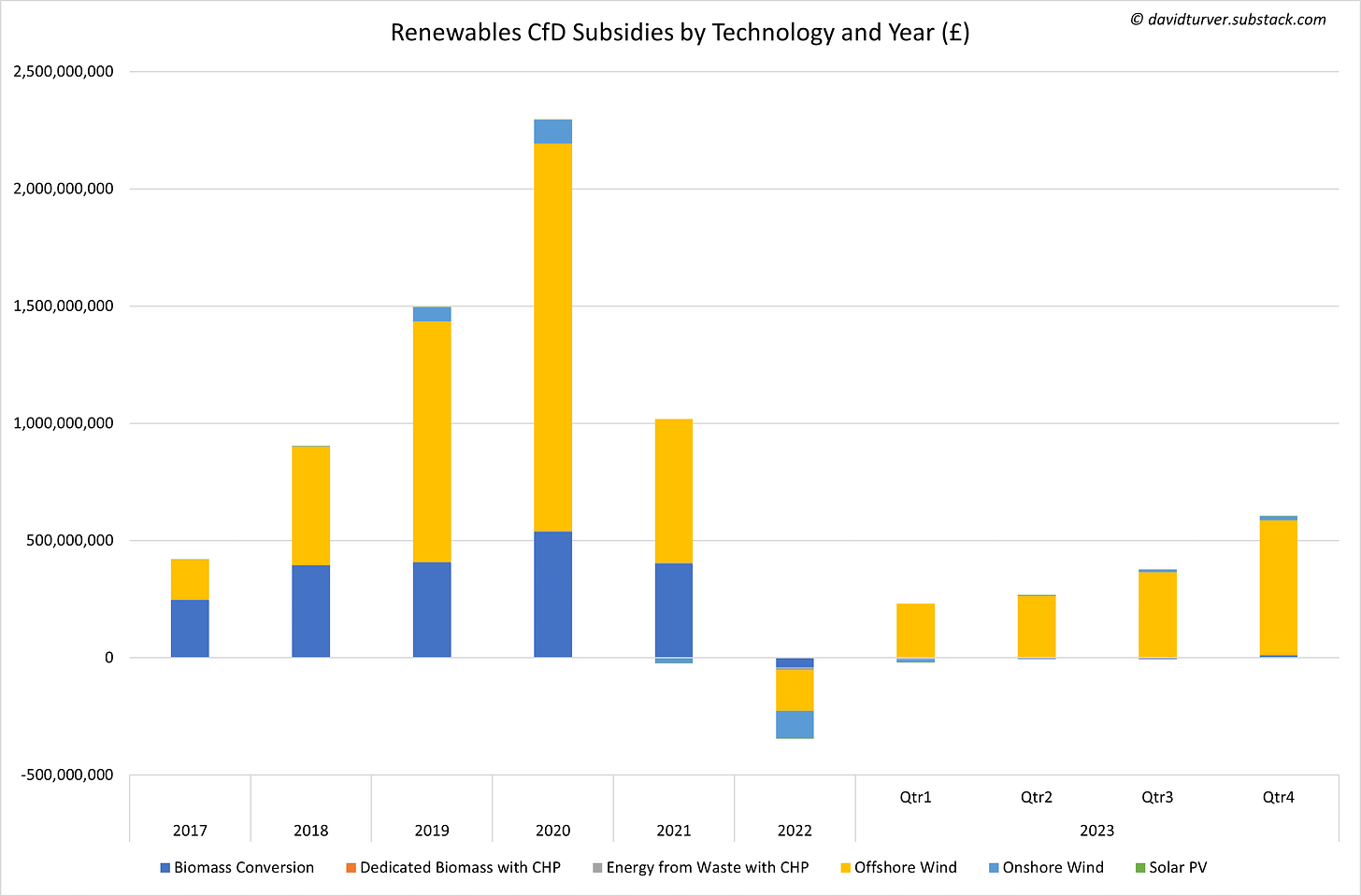"Record CfD Subsidies for Wind Power" by David Turver
"December 2023 saw the highest CfD subsidies on record for wind power"
I highly recommend reading and archiving the following very helpful, concise analysis by David Turver of subsidies paid by us to industrial wind power generators which prove the falsity of the propaganda myth that “renewables” are cheap.
Record CfD Subsidies for Wind Power
December 2023 saw the highest CfD subsidies on record for wind power
By David Turver • 12 January 2024
Overnight, the Low Carbon Capture Company (LCCC) released the full data for renewables subsidies for December 2023. This is a short article that analyses the level of subsidies going to wind and other renewables.
Record CfD Subsidies for Wind Power in December 2023
Figure 1 shows the monthly subsidies for onshore (grey bars) and offshore (blue bars) wind since 2017. The orange area is offshore generation and the yellow area in onshore generation each month.
December saw the highest subsidies on record at over £255m. The next highest month was February 2020 at £188m. The months for highest generation tend to be December to February or March of the following year, so we might expect subsidies to continue at similar levels for some months to come.
The subsidies are paid to top-up the revenue of wind farm operators to the value of their Contract for Difference (CfD) when the market reference price is below the strike price of the CfD. Typically, the market reference price is set by gas-fired generation, so when the blue/grey bars are positive wind power is more expensive than gas. When the bars are negative, wind is cheaper than gas.
For some months in late-2021 and during 2022, gas was more expensive, so the operators had to pay back some of what they received so they did not get more than their strike price. However, gas prices have fallen since 2022 and CfD strike prices are index-linked and rise each year in line with inflation. So, even though gas prices are at the high end of their pre-crisis range, the gap between strike prices and gas prices has been rising again so subsidies have gone up.
However, as more wind farms have come online and taken up their CfD contracts, the amount of generation has also risen, so the average subsidy per MWh in 2023 was lower than that in 2020. If gas prices stay around their current level, we can expect another jump in subsidies from April 2024 as CfD strike prices index upwards again.
Total CfD Subsidies by Year
Figure 2 total CfD subsidies by year across all technologies.
The CfD subsidies for technologies other than wind are tiny in comparison. Overall subsidies for 2023 were the third highest on record at £1.45bn, just under the £1.5bn recorded in 2019. The subsidies for 2023 rose steadily each quarter, with 4Q23 coming in at £604m, close to the peak of £658m in 4Q20. It is therefore entirely possible that 2024 will run 2020 close to become the record year for subsidies.
Looking at 2022, the £346m paid back during that year is trivial in comparison to the overall £7.2bn paid in subsidies since 2017.
My conclusion from this is that renewables are not and never have been cheap. There was of course the anomaly of the gas supply crisis in 2022, exacerbated by Putin’s invasion of Ukraine. Gas prices are still elevated even though the crisis has abated, but subsidies are back to high levels and look set to increase. Do not let anyone tell you that renewables are cheap.
Please share David’s original post and consider subscribing to his Substack if you don’t already.





Thank you for explaining this. The CfD subsidies are ongoing and contractual, right? If I understand it correctly, these subsidies are separate from and in addition to all the subsidies paid for the actual building and installation of the wind farms?